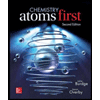
(a)
Interpretation:
The mechanism of the product and the role of sulfuric acid, isomer and chirality of the alcohol should be identified.
Concept introduction:
Isomer: A compound is same molecular formula and different in structural formula is called isomer.
A carbon atom is attached by the four different groups is called chiral carbon.
(b)
Interpretation:
The mechanism of the product and the role of sulfuric acid, isomer and chirality of the alcohol should be identified.
Concept introduction:
Isomer: A compound is same molecular formula and different in structural formula is called isomer.
A carbon atom is attached by the four different groups is called chiral carbon.
(c)
Interpretation:
The mechanism of the product and the role of sulfuric acid, isomer and chirality of the alcohol should be identified.
Concept introduction:
Isomer: A compound is same molecular formula and different in structural formula is called isomer.
A carbon atom is attached by the four different groups is called chiral carbon.
Want to see the full answer?
Check out a sample textbook solution
Chapter 23 Solutions
Chemistry: Atoms First
- Draw and name the five cycloalkane structures of formula C5H10. Can any of these structures give rise to geometric (cis-trans) isomerism? If so, show the cis and trans stereoisomersarrow_forwardAn isomer of C6H12O could contain a carboxylic acid. True or false?arrow_forwardDraw the condensed structures and give the systematic names for all the alkenes with molecular formula C6H12, ignoring stereoisomers. (Hint: There are 13.) b. Which of the alkenes have E and Z isomers? c. Which of the alkenes is the most stable? d. Which of the alkenes is the least stable?arrow_forward
- Give the molecular formula of a hydrocarbon containingsix carbon atoms that is (a) a cyclic alkane, (b) a cyclicalkene, (c) a linear alkyne, (d) an aromatic hydrocarbon.arrow_forwardAcetyl chloride, CH3COCl, reacts with the hydroxyl groupsof alcohols to form ester groups with the elimination ofHCl. When an unknown compound X with formulaC4H8O3 reacted with acetyl chloride, a new compound Ywith formula C8H12O5 was formed.(a) How many hydroxyl groups were there in X?(b) Assume that X is an aldehyde. Write a possible structure for X and a possible structure for Y consistent with your structure for X.arrow_forwardEnter the molecular formula for butane, C4H10?arrow_forward
 Chemistry: Principles and PracticeChemistryISBN:9780534420123Author:Daniel L. Reger, Scott R. Goode, David W. Ball, Edward MercerPublisher:Cengage Learning
Chemistry: Principles and PracticeChemistryISBN:9780534420123Author:Daniel L. Reger, Scott R. Goode, David W. Ball, Edward MercerPublisher:Cengage Learning Chemistry: Principles and ReactionsChemistryISBN:9781305079373Author:William L. Masterton, Cecile N. HurleyPublisher:Cengage Learning
Chemistry: Principles and ReactionsChemistryISBN:9781305079373Author:William L. Masterton, Cecile N. HurleyPublisher:Cengage Learning Chemistry & Chemical ReactivityChemistryISBN:9781337399074Author:John C. Kotz, Paul M. Treichel, John Townsend, David TreichelPublisher:Cengage Learning
Chemistry & Chemical ReactivityChemistryISBN:9781337399074Author:John C. Kotz, Paul M. Treichel, John Townsend, David TreichelPublisher:Cengage Learning Chemistry & Chemical ReactivityChemistryISBN:9781133949640Author:John C. Kotz, Paul M. Treichel, John Townsend, David TreichelPublisher:Cengage Learning
Chemistry & Chemical ReactivityChemistryISBN:9781133949640Author:John C. Kotz, Paul M. Treichel, John Townsend, David TreichelPublisher:Cengage Learning Chemistry: The Molecular ScienceChemistryISBN:9781285199047Author:John W. Moore, Conrad L. StanitskiPublisher:Cengage Learning
Chemistry: The Molecular ScienceChemistryISBN:9781285199047Author:John W. Moore, Conrad L. StanitskiPublisher:Cengage Learning ChemistryChemistryISBN:9781305957404Author:Steven S. Zumdahl, Susan A. Zumdahl, Donald J. DeCostePublisher:Cengage Learning
ChemistryChemistryISBN:9781305957404Author:Steven S. Zumdahl, Susan A. Zumdahl, Donald J. DeCostePublisher:Cengage Learning





